Did you discover newly laid box turtle eggs by one pet turtles? Are you wondering how to take care of your baby box turtle? You are in the right place. This post provides a full overview of everything you need to know about box turtle breeding and how to take care of box turtle babies.
Disclosure: This post contains affiliate links. At no extra cost for you, I may receive a commission if you purchase products mentioned below.
Box turtle mating season
Box turtles come out of hibernation in March or early April in most areas of their natural range and adult males usually have a strong urge to find a mate. They may not feel like eating, but if there is a female box turtle around, he’ll feel like reproducing. Many owners of multiple box turtles will tell you stories about their male box turtle’s clumsy attempts to mate or about an anxious female looking for a place to lay her eggs.
How to find out if your box turtle is male or female? Click here
Everything is left to chance and the owners are quite surprised when they see box turtle babies emerge. Most owners don’t have a clue how to take care of a box turtle baby. This should not be the way to bring baby box turtles into the world. All breeding of captive box turtles should be done in a responsible manner.
Not every box turtle is ideal to breed

The stresses and energy drain on both the male and female box turtles during breeding, egg formation, and laying are considerable and can make them more prone to illness and death.
If you do raise box turtle hatchlings, what are your plans for them? Don’t allow siblings to breed with each other. Therefore, you’ll have to keep males and females apart. You may think you will give them away. But who knows if other people will give them the good care they deserve.
You should not release captive-bred turtles into the wild without investigating every outcome of your actions. Most states don’t allow it and if your turtles have an illness, they could spread it to all the others turtles. A release of new turtles into an area that already has a resident population could may make it harder for them to find food. As you see, you need to answer many questions before you allow your pets to breed. If you decide to breed your pets, do it correctly.
Sometimes, however, you may find your female box turtle lay eggs without your knowledge. Irrespective whether you took the active decision to breed box turtles or not, this page will tell you what to do to make the box turtle babies survive and strong.
Taking care of the breeding pair
Do not allow related turtles to breed. This means no brother/sister pairs or mother/son or father/daughter pairings. The breeding pair should have optimum health. They should have been in your care for several years so you know they have eaten well and have gotten the necessary vitamins and calcium for good egg development.
A sickly female that is allowed to breed may form thin-shelled eggs that easily break within her or don’t develop properly. Do not allow females with a damaged shell to breed. There may be internal damage to her pelvis which will not allow the eggs to pass out. Eggs retained in the body will cause death unless they are surgically removed.
Where do box turtles lay their eggs?
After mating in the spring, the female turtle looks for nesting sites in June or July. Provide the egg-bearing females with a solitary outdoor pen that faces south and contains several good sites for egg laying. This pen should be equipped like the main pen, with hiding places, sunny and shady spots. It should also have several areas with soft top soil that is at least 8 inches deep. Place large tree limbs or rocks on top of the soil. The nesting female may build her egg chamber next to a limb or rock.
The female box turtle usually lays her eggs in a sunny and yet humid spot with soft soil
Digging the egg chamber is very time-consuming for her and may take up to 8 hours to dig. The female begins by digging with her back feet only and uses her feet and legs to press the soil up against the walls of the chamber. Since it is often not visible for box turtle owners that a female may be carrying eggs, this could be one sign.
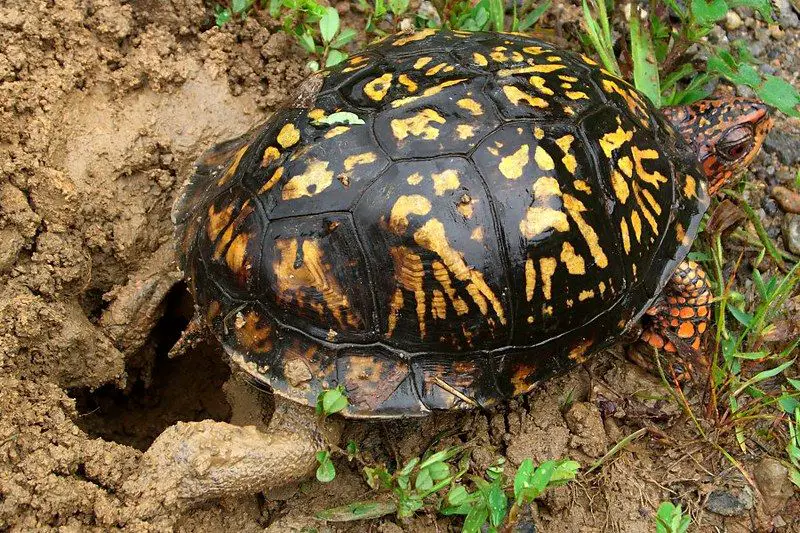
The turtle makes a smooth receptacle to receive the eggs. A female box turtle usually lays three to four eggs. They are white and oval. The shells are thin-walled, flexible and permeable.
The female will cover the eggs with the soil she removed from the hole, tamping the soil around the eggs with her hind feet. She will leave the area in such a manner you may not be able to tell there ever was a hole.
Taking care of the box turtle eggs
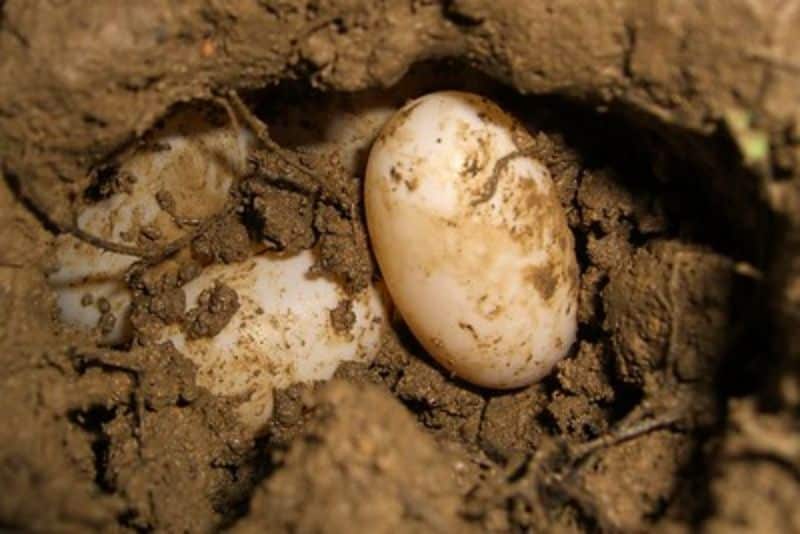
After the female turtle has laid her eggs, the box turtle hatchlings may stay inside the eggs for an extended period of time.
Protect in-ground nest sites with a wire mesh cover. Secure the wire cover to the ground so animals cannot get under it and destroy the eggs. This will also protect the site from other turtles and keeps the hatchlings from escaping.
Should you incubate box turtle eggs?
Let Mother Nature hatch the eggs if possible. If you provide the turtle with several sites to lay her eggs, she will probably pick one with the best chance of survival. It’s also best not to move turtle eggs once they have been laid. The expense and expertise needed to artificially incubate turtle eggs is best left to expert breeders. However, if you want to attempt hatching the eggs yourself, or if you find eggs laid in a terrarium, you can check out our detailed post on how to incubate turtle eggs.
If you incubate the eggs yourself, a good method is to place the eggs in a small plastic margarine tub that has been filled with moist vermiculite.
Poke holes in the bottom of the container so excess water can drain out. Place each egg in a depression you make with your thumb. You don’t need to bury the eggs. Do not turn the eggs over as you remove them from the ground. Place them in the tub in the exact same orientation as you find them. Poke holes into the lid of the margarine tub and place it loosely on the tub. Place the tub in an egg incubator set at 84° F. Every 2-3 days mist the substrate around the eggs with distilled water. If you notice the vermiculite drying up add water. At 84° F, the eggs should hatch in 65-70 days.
The box turtle hatching
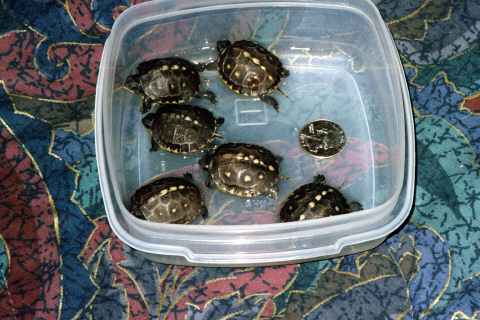
The baby box turtle hatchlings will emerge in 70-90 days depending on how quickly the embryos develop, which is dependent on the nest temperature. If the ground is hard, you may want to water the area after the 75th day.
If eggs are laid above ground or in water, they are most likely infertile. Not every clutch of eggs will hatch and young females will often deposit infertile eggs on the ground or dig shallow nests.
Taking care of the baby box turtle hatchlings
In the wild, box turtle hatchling mortality rate is very high and very few hatchlings live past their first winter. Baby turtles are subjected to a lot of stress and are eaten by everything from birds, raccoons, rodents, and ants.
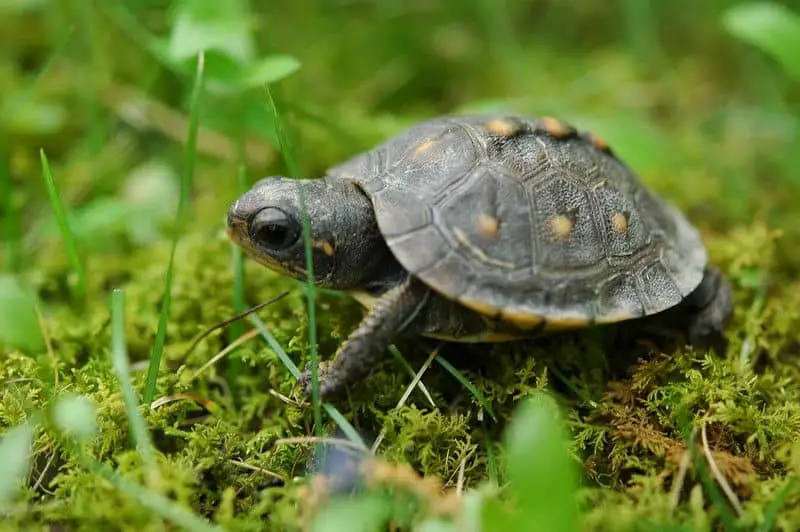
If they don’t dig down deeply enough in winter, they freeze, and if the springs rains come too late, the ground may not soften and they can be buried alive.
As the caretaker of these baby box turtles, you also have a lot to do to insure their welfare. I’ve raised both ornate and baby Eastern box turtles and their care is similar.
I separate ornate hatchlings from each other as they have proven to be much more aggressive and will bite at each other’s tails and legs. I always feed hatchlings separately as they may accidentally bite each other as they go for the food. I’ve heard horror stories of box turtle babies losing eyes or having their jaws broken by other feeders. This is totally avoidable.
When you feed several turtle babies together, it may also happen that the weakest or most timid little fellow will not get anything. Make sure each hatchling gets its share.
Caring for your newly born box turtle hatchlins: Tips
Housing
I keep box turtle hatchlings indoors for their first year. I place them in 10 gallon tanks with a deep substrate of moist terrarium moss and reptile bark substrate and rinse the bedding thoroughly clean before use. Furthermore, I am misting the substrate daily to keep the humidity high. For heating, I keep an overhead lamp with a 60 watt bulb (or 40 watt in the summer) for 12 hours each day. A low wattage or thermostat controlled under tank heater or flex-tape type heaters can also be used on one side of the tank if temperature is hard to maintain.
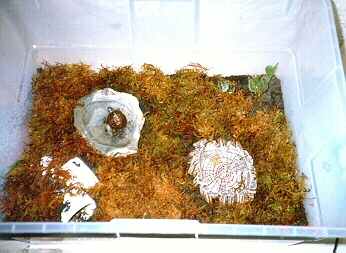
Thermometers are attached to the tank at several locations and the heat maintained at 82° F (28° C) during the day and dropped as low as 75° (24° C) at night. Always fill a shallow water dish with fresh water. I even place the babies into the water each day to be sure they are drinking. A hide box is provided.
A UVA and UVB lamp like Zoo Med’s Avian Sun 5.0 is necessary only if you cannot get your hatchling outdoors under the sunlight at least once a week for an hour. I place the turtles into shallow plastic sweater boxes that are floored with reptile bark and moss and set them outside in filtered sunlight.
DO NOT LEAVE THEM ALONE. If the sun is too intense, they will quickly overheat. On very sunny days, I place a leafy branch over the box for more shade and hiding.
Mainainance of the box turtle aquarium
Clean the tank at least once a month, twice a month if you have more than one baby box turtle in a tank. Move the turtle to a safe place, do not let it wander in the room as they are very fast and can hide well. The bedding can be reused if it hasn’t been defecated on by the hatchlings.
Most turtles use the water dish as a portable potty and you should clean it every day, or as often as needed to keep it clean and drinkable. Remove the bedding and rinse it well. Clean the tank itself with a commercial pet housing cleaning product. These products kill germs on contact and leave no residual odors that may effect reptiles. Good housekeeping will go a long way toward keeping your hatchlings healthy. Set up a schedule for regular cleaning and many of the common problems will not occur because germs will not accumulate to dangerous levels.
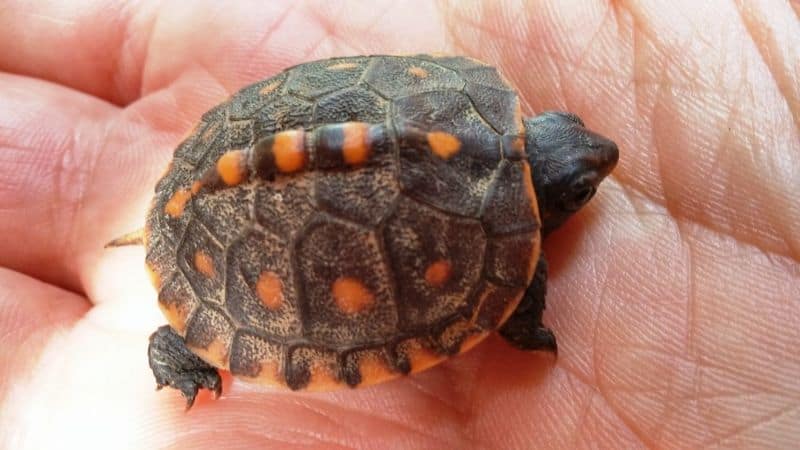
Keeping box turtle hatchlings outside
If you decide to keep your hatchlings outside, provide them with their own outdoor enclosure and protect them from birds and ants. A raised garden bed that can be covered by a screen is ideal. It doesn’t have to be large but should include areas of sun and shade and a hide box. Ants, especially fire ants, have killed many baby reptiles. Take every precaution to avoid them. Place ant bait in containers outside the turtle’s pen to kill ants before they become a problem. Remove the food dishes quickly after feeding, or feed the turtles in another area.
You can find our full and detailed post about box turtle habitats here.
Feeding the box turtle babies
Hatchlings need water every day but they don’t need to be fed every day. With my first turtle babies, I followed the advice of several books and feed my hatchlings daily. Their meals contained only protein like tubiflex worms, Repti-Ten Sticks, soaked dog kibble, chopped worms, vitamin and mineral supplements for over a year. I gave them no vegetables or fruits since the literature of the day claimed hatchlings were carnivorous. They grew very quickly and had large shells, but some couldn’t right themselves if they tipped over. Their leg and neck muscles were too weak for their large size. They also has slight pyramiding of the scutes. The photo below shows what pyramiding looks like. The scutes are pointy or raised in the centers. These three years old box turtles were fed pinky mice several times a week, a diet too rich in protein.
How often should you feed them?
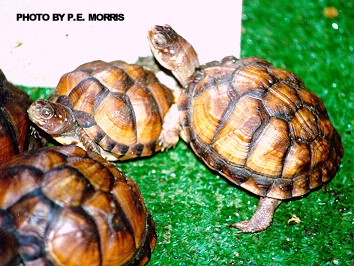
I fed my next box turtle hatchlings only every other day and gave them adult menu of very finely chopped protein, vegetables and fruits. In two months, they began to eat the vegetables before the meat. It may be true that hatchlings are more carnivorous than adults, but you should give them the choice to eat plant matter at every meal. Their bodies will tell them when they need vegetables, plus it’s good to get them use to seeing and smelling plant foods. These babies grew at a more normal rate with normal sized shells compared to their bodies. I can only guess that their internal organs are also benefiting from the more natural growth rate.
Pick up the food dishes after about an hour. If the food remains in the tank for long, the turtles may walk over it and make the tank messy. The food could attract bugs or rot.
Medical Care for baby box turtles
If your baby box turtle does gets sick (for example, it stops eating, or its eyes become swollen shut, or its shell begins to deform), you need to examine your rearing technique. Concentrate on giving it a lot of tender, loving care. There isn’t much a veterinarian can do for a tiny turtle. Some vets will give them injections or force-feed them, but there is very little published information about hatchling health care and I know of baby turtles that have died after receiving shots. The best thing to do is try to find out what in your care routine is making your turtle sick and then correct it.
Give the turtle extra warmth, nutritious foods, rest and oral or topical medicines. Ideally you can avoid most problems from the start by giving the hatchlings the best care. For example, one way to avoid intestinal worms is to not feed garden worms and slugs to hatchlings. If hatchlings become worm-infested, their tiny bodies may not be able to handle it, nor the shots that may be required to kill the worms. I feed hatchlings farm-raised live foods that I order online. Waxworms, freshly molted mealworms and superworms are good first live foods as they are soft bodied.
Check out our post about health information for box turtles here.
Breeding baby box turtles summary
Hatchling box turtles are a joy to have, but they require a lot of extra care and time. Many people have raised baby box turtles, some with more success than others. The important difference in raising perfectly formed, strong and healthy box turtles versus weak, abnormally shaped and sickly ones is devotion to their care and your continuing efforts to learn from your mistakes and those of others.
Have you already raised baby box turtles? If yes, do you have any other tips or questions? Just let us know in the comment section. If you have some pictures of your cute baby box turtles, feel free to share them with us at boxturtlesite@gmail.com
If you want to look at some cute box turtle baby pictures, click here to get to our image gallery.
Click on the images below to pin this post for later
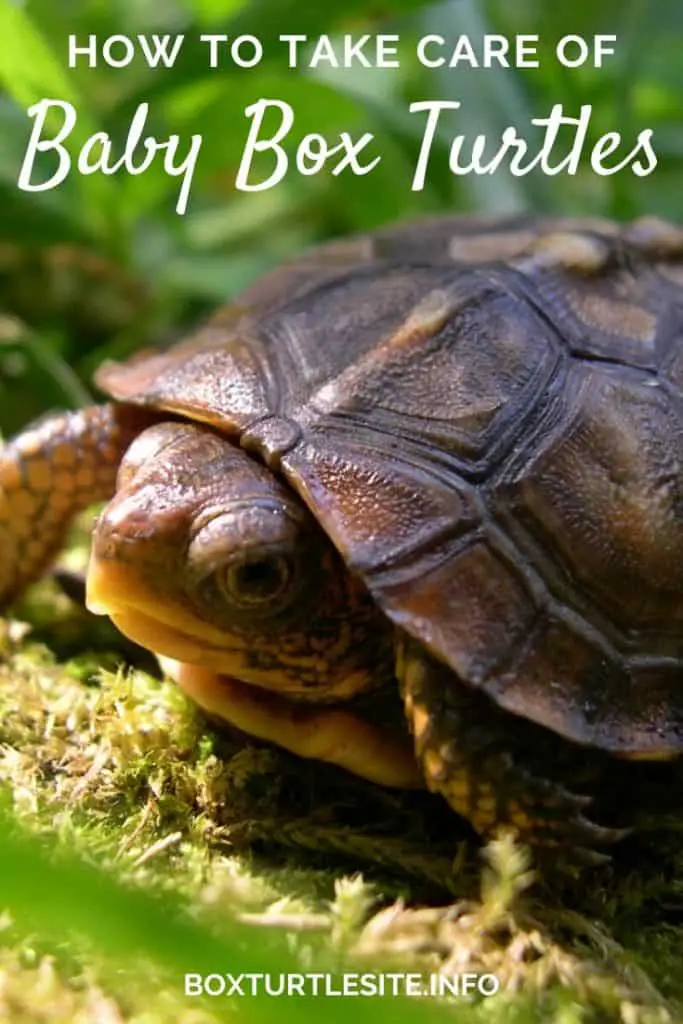

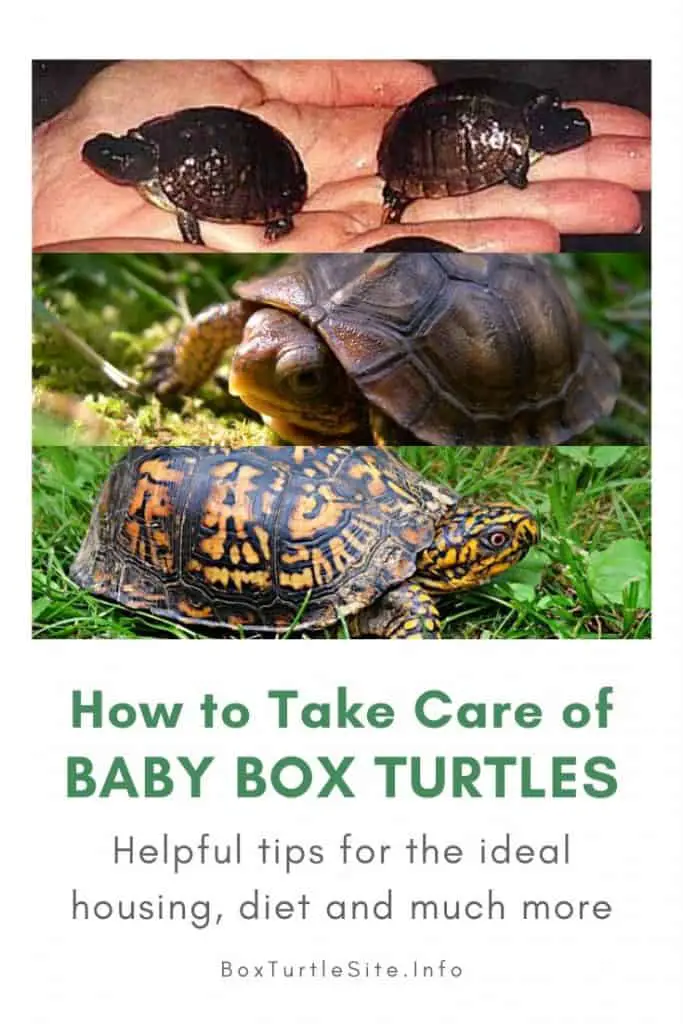
5 thoughts on “From Egg to Baby Box Turtle – Breeding Tips and Tricks”
Comments are closed.